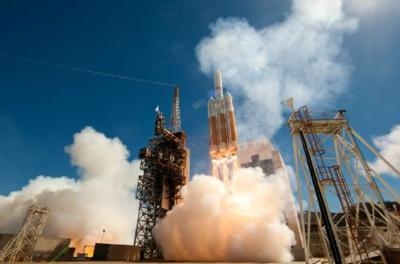Fri, Aug 30, 2013
Payload To Support National Defense Interests
A United Launch Alliance (ULA) Delta IV Heavy rocket carrying a payload for the National Reconnaissance Office (NRO) lifted off from Space Launch Complex-6 at California's Vandenberg Air Force Base at 1103 PDT Wednesday. Designated NROL-65, the mission is in support of national defense. This is ULA's eighth launch in 2013, the 24th Delta IV mission and the second Delta IV Heavy launch from Vandenberg.

"We are truly honored to deliver this critical asset to orbit," said Jim Sponnick, ULA vice president, Atlas and Delta Programs. "The ULA Delta IV Heavy is currently the world's largest rocket, providing the nation with reliable, proven, heavy lift capability for our country's national security payloads from both the east and west coasts. I congratulate the combined NRO, Air Force, ULA, and supplier team on today's successful launch of the NROL-65 mission."
This mission was launched aboard a Delta IV Heavy configuration Evolved Expendable Launch Vehicle (EELV) which featured a center common booster core along with two strap-on common booster cores. Each common booster core was powered by an RS-68 Liquid Hydrogen/Liquid Oxygen engine producing 663,000 pounds of thrust. A single RL10 Liquid Hydrogen/Liquid Oxygen engine powered the second stage. The booster and upper stage engines are both built by Aerojet Rocketdyne. The payload was encased by a 16.7-foot diameter, 65-foot, metallic tri-sector payload fairing. ULA constructed the Delta IV Heavy launch vehicle in Decatur, AL.
ULA's next launch is the Atlas V AEHF-3 mission for the United States Air Force scheduled on Sept. 18, from Space Launch Complex-41 at Cape Canaveral Air Force Station, FL.
The EELV program was established by the United States Air Force to provide assured access to space for Department of Defense and other government payloads. The commercially developed EELV Program supports the full range of government mission requirements, while delivering on schedule and providing significant cost savings over the heritage launch systems.
(Image provided by ULA)
More News
Light Gun A handheld directional light signaling device which emits a brilliant narrow beam of white, green, or red light as selected by the tower controller. The color and type of>[...]
"The journey to this achievement started nearly a decade ago when a freshly commissioned Gentry, driven by a fascination with new technologies and a desire to contribute significan>[...]
Aero Linx: JAARS, Inc. For decades now, we’ve landed planes on narrow rivers and towering mountains. We’ve outfitted boats and vehicles to reach villages that rarely se>[...]
"Our driven and innovative team of military and civilian Airmen delivers combat power daily, ensuring our nation is ready today and tomorrow." Source: General Duke Richardson, AFMC>[...]
Aircraft Conflict Predicted conflict, within EDST of two aircraft, or between aircraft and airspace. A Red alert is used for conflicts when the predicted minimum separation is 5 na>[...]
 ANN's Daily Aero-Term (04.20.24): Light Gun
ANN's Daily Aero-Term (04.20.24): Light Gun Aero-News: Quote of the Day (04.20.24)
Aero-News: Quote of the Day (04.20.24) ANN's Daily Aero-Linx (04.21.24)
ANN's Daily Aero-Linx (04.21.24) Aero-News: Quote of the Day (04.21.24)
Aero-News: Quote of the Day (04.21.24) ANN's Daily Aero-Term (04.21.24): Aircraft Conflict
ANN's Daily Aero-Term (04.21.24): Aircraft Conflict



